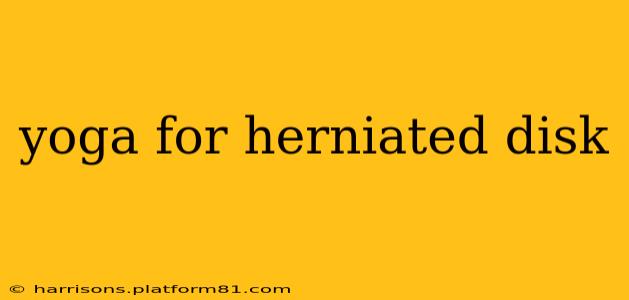A herniated disc, also known as a slipped or ruptured disc, occurs when the soft, gel-like center of an intervertebral disc pushes through a tear in the tougher outer layer. This can cause significant pain, numbness, and weakness radiating down the leg (sciatica) or arm. While surgery may be necessary in some cases, many individuals find relief and improved function through conservative treatments, including yoga. However, it's crucial to approach yoga with caution and proper guidance when dealing with a herniated disc. This post explores how specific yoga practices can help manage pain and promote healing, while emphasizing the importance of professional advice.
Is Yoga Safe for a Herniated Disc?
Yes, but with important caveats. Yoga can be incredibly beneficial for managing herniated disc pain, improving flexibility, and strengthening core muscles. However, it's essential to practice modified poses, avoid movements that aggravate pain, and ideally, work with a qualified yoga therapist experienced in working with back injuries. Improper techniques can exacerbate the condition, leading to further injury.
What Type of Yoga is Best for a Herniated Disc?
Gentle forms of yoga are best suited for individuals with herniated discs. These styles focus on mindful movement, breathwork, and relaxation, rather than vigorous poses. Some good options include:
- Restorative Yoga: This style emphasizes relaxation and stress reduction. Poses are held for extended periods, supporting the body with props like bolsters and blankets.
- Yin Yoga: This involves holding passive stretches for several minutes to target deep connective tissues. It improves flexibility and reduces tension in the spine.
- Hatha Yoga (modified): Hatha yoga can be adapted to suit individual needs. Modifications can be made to traditional poses to reduce strain on the spine.
What Poses Should I Avoid with a Herniated Disc?
Certain yoga poses should be avoided or modified significantly until your condition improves. These include:
- Forward bends (without modifications): Deep forward bends can increase pressure on the herniated disc.
- Backbends (without modifications): These can also put excessive stress on the spine.
- Twists (without modifications): Deep twists may irritate the affected area.
- Inversions (without modifications): Headstands and handstands should be avoided unless specifically guided by a qualified instructor familiar with your condition.
Can Yoga Help Reduce Herniated Disc Pain?
Many individuals report significant pain reduction with a tailored yoga program. The benefits stem from:
- Improved flexibility: Yoga stretches and strengthens the muscles supporting the spine, which can alleviate pressure on the herniated disc.
- Increased core strength: A strong core provides better spinal stability and support.
- Stress reduction: Yoga's relaxation techniques can help manage stress, a factor that can exacerbate back pain.
- Improved posture: Good posture reduces strain on the spine.
What are the Benefits of Yoga for a Herniated Disc?
Beyond pain reduction, yoga offers several additional benefits:
- Improved mobility: Regular practice can increase range of motion and reduce stiffness.
- Enhanced balance and coordination: This is especially helpful as you recover strength and stability.
- Reduced inflammation: Certain yoga practices may help to reduce inflammation in the affected area.
- Improved overall well-being: The mind-body connection fostered in yoga can lead to improved mental and emotional health.
How Can I Find a Qualified Yoga Instructor for a Herniated Disc?
Finding a knowledgeable instructor is crucial. Look for instructors certified in therapeutic yoga or those with experience working with individuals with spinal injuries. Many yoga studios offer specialized classes for back pain or injuries. Discuss your condition with the instructor before starting any program.
What Other Treatments Can I Combine with Yoga for a Herniated Disc?
Yoga is often part of a comprehensive treatment plan. Other treatments may include:
- Physical therapy: A physical therapist can provide personalized exercises and guidance.
- Medication: Pain relievers and anti-inflammatory drugs can help manage pain and inflammation.
- Ice and heat therapy: Applying ice or heat can reduce pain and swelling.
- Core strengthening exercises: Specific exercises can help strengthen the muscles supporting the spine.
Disclaimer: This information is for educational purposes only and should not be considered medical advice. Always consult with your doctor or a qualified healthcare professional before starting any new exercise program, especially if you have a medical condition like a herniated disc. Improper exercise can worsen your condition. Work with a qualified yoga instructor experienced in adapting poses for spinal injuries to ensure safe and effective practice.
